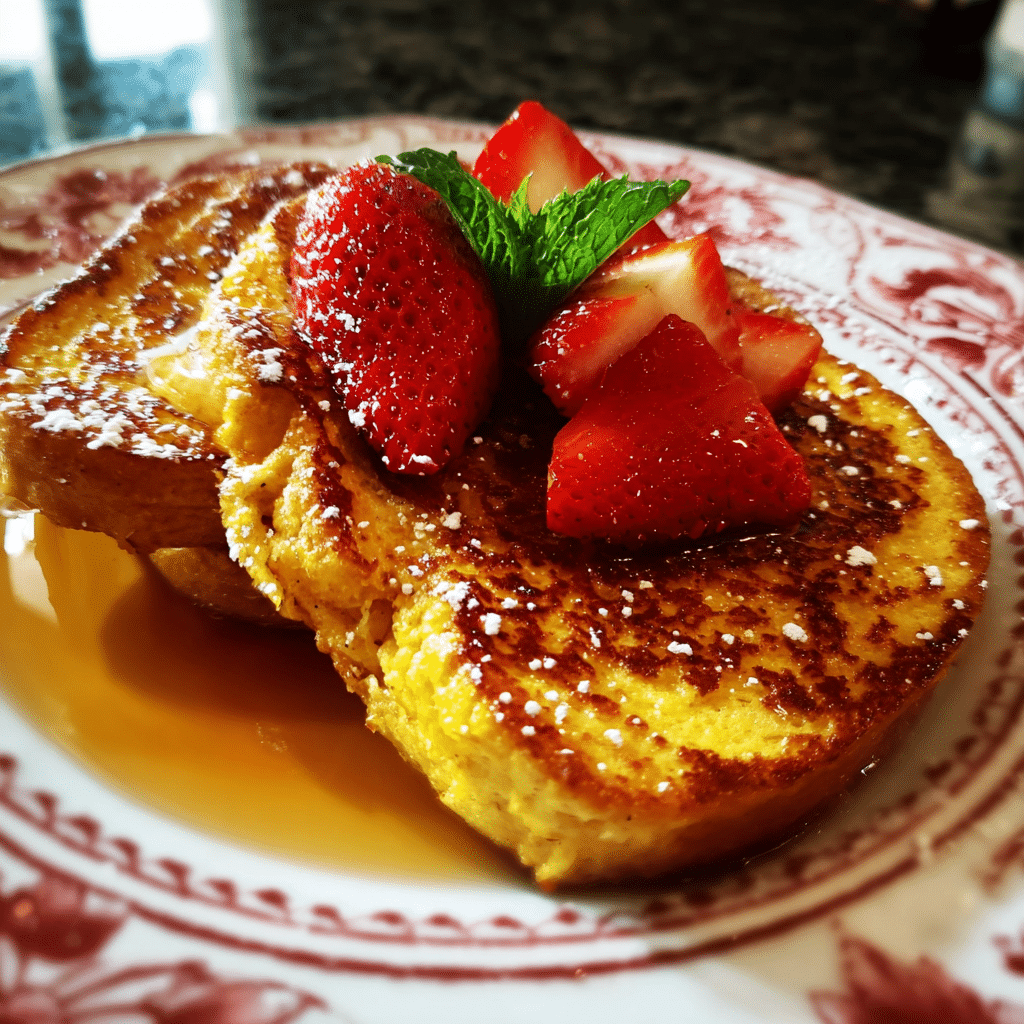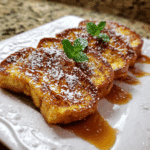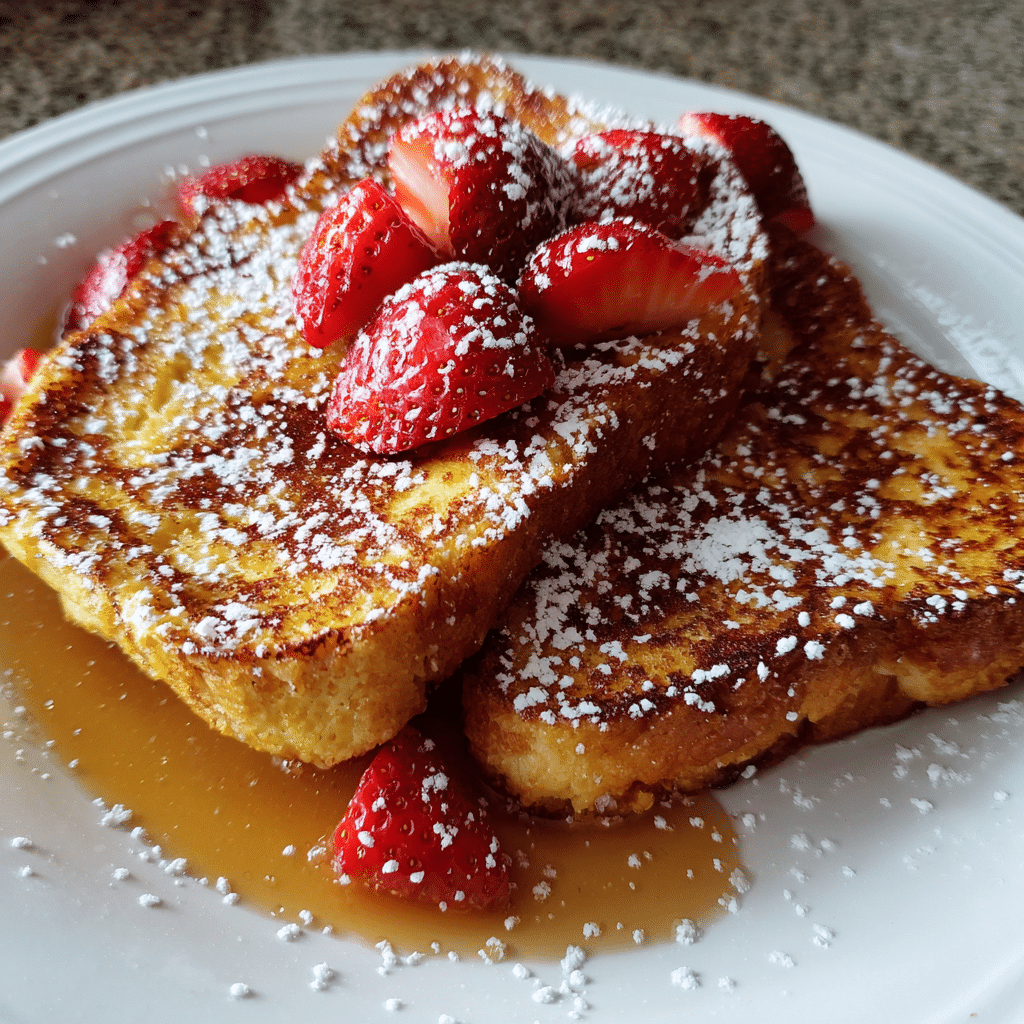Why You’ll Love This Recipe
Classic French toast is one of those comforting breakfast dishes that never goes out of style. Made with simple ingredients like bread, eggs, milk, and a touch of cinnamon, it transforms everyday staples into something indulgent and special. The bread soaks up the custard mixture, then cooks to golden perfection, resulting in a crispy exterior and a soft, custardy interior. It’s versatile enough to be dressed up with fresh fruit, syrup, powdered sugar, or even a dollop of whipped cream, yet simple enough for a quick weekday breakfast. Whether you are serving it for a family brunch, a holiday morning, or just treating yourself, French toast offers the perfect balance of sweetness, richness, and nostalgia. With easy steps and pantry-friendly ingredients, this recipe proves that sometimes the best dishes are the simplest.


Classic French Toast – A Timeless Breakfast Favorite
- Total Time: 25 minutes
- Yield: 4 servings
- Diet: Vegetarian
Description
Classic French Toast is a timeless breakfast dish made with thick slices of bread soaked in a sweet egg custard, then pan-fried until golden and crisp on the outside while soft and fluffy inside.
Ingredients
- 4 large eggs
- 1 cup whole milk
- 1/4 cup heavy cream
- 2 tbsp granulated sugar
- 1 tsp vanilla extract
- 1/2 tsp ground cinnamon
- Pinch of salt
- 8 slices brioche or challah bread (thick-cut)
- 2 tbsp unsalted butter (for frying)
- Maple syrup, for serving
- Powdered sugar, for garnish
- Fresh berries, for serving (optional)
Instructions
- In a shallow dish, whisk together eggs, milk, heavy cream, sugar, vanilla, cinnamon, and salt until well combined.
- Heat a skillet or griddle over medium heat and add 1 tbsp butter.
- Dip each slice of bread into the egg mixture, soaking for about 20–30 seconds per side.
- Place soaked bread on the skillet and cook for 2–3 minutes per side, or until golden brown and cooked through.
- Transfer to a plate and repeat with remaining bread, adding more butter as needed.
- Serve warm with maple syrup, powdered sugar, and fresh berries if desired.
Notes
- Day-old bread works best as it absorbs the custard without becoming soggy.
- Use brioche or challah for extra richness, but sandwich bread can also be used.
- Keep cooked slices warm in a low oven (200°F) while preparing the rest.
- Prep Time: 10 minutes
- Cook Time: 15 minutes
- Category: Breakfast
- Method: Pan-Frying
- Cuisine: French
Ingredients
(Tip: You can find the complete list of ingredients and their measurements in the recipe card below.)
Bread
The foundation of French toast; slightly stale bread works best as it absorbs the custard without falling apart. Brioche or challah are excellent choices for a richer flavor.
Eggs
Whisked eggs form the base of the custard, adding richness and structure to the soaked bread.
Milk
Whole milk is commonly used, lending creaminess to the custard. For extra indulgence, half-and-half or cream can be substituted.
Sugar
A small amount of sugar sweetens the custard mixture, balancing the flavors.
Vanilla extract
This adds warm, aromatic notes that enhance the overall flavor of the French toast.
Ground cinnamon
A touch of spice that pairs beautifully with vanilla and sugar, adding depth and warmth.
Salt
Just a pinch elevates the sweetness and ensures the flavors remain balanced.
Butter
Used for frying, butter provides a golden crust and a subtle richness.
Maple syrup
The classic topping for French toast, offering natural sweetness and a luscious finish.
Powdered sugar
Optional but delightful for dusting, adding a bakery-style touch to the finished dish.
Directions
Begin by preparing the custard. In a shallow bowl, whisk together eggs, milk, sugar, vanilla extract, cinnamon, and a pinch of salt until well combined.
Preheat a skillet or griddle over medium heat and add a small amount of butter to coat the surface. Dip each slice of bread into the custard mixture, allowing it to soak for a few seconds on each side. Be careful not to oversaturate the bread.
Transfer the soaked bread to the hot skillet and cook until golden brown on one side, then flip and cook the other side until evenly browned and cooked through. Repeat with remaining slices, adding more butter to the skillet as needed.
Serve the French toast warm, topped with maple syrup, powdered sugar, or fresh fruit for a classic presentation.
Essential Equipment
Must-Have Tools to Get Rolling
Here’s what you’ll want to have on hand:
Silicone Spatula – Durable, heat-resistant silicone spatula perfect for mixing, scraping, and spreading. Gentle on non-stick cookware and easy to clean.
Large pot – You’ll need this to boil the whole cabbage head and soften the leaves.
large bowl –Spacious, durable large bowl ideal for mixing, serving, or food preparation. Made from sturdy material and easy to clean.
Sharp knife – For coring the cabbage and slicing out the thick stem in each leaf. A paring knife works best.
Mixing bowl – A big bowl makes it easier to combine your meat and rice filling evenly.
Cutting board – For prepping cabbage leaves and rolling them like a pro.
9×13-inch baking dish – Ideal size to fit your rolled cabbage leaves snugly and prevent them from unraveling.
knife – A sharp, durable kitchen knife perfect for slicing, chopping, and dicing with ease.
Servings and timing
This recipe yields about 4 servings, depending on bread slice size. Preparation takes approximately 10 minutes, while cooking requires 15 minutes. The entire dish can be ready in about 25 minutes, making it perfect for both quick breakfasts and leisurely brunches.
Storage/reheating
Leftover French toast can be stored in an airtight container in the refrigerator for up to three days. To reheat, place slices in a toaster oven or skillet to restore crispness, or microwave gently for convenience. French toast also freezes well – simply wrap individual slices and reheat in the oven or toaster when needed.
Variations and Customizations
Stuffed French Toast
Fill with cream cheese, fruit preserves, or Nutella before cooking for a decadent twist.
Savory French Toast
Omit sugar and cinnamon, and top with cheese, herbs, or even bacon for a savory breakfast.
Spiced French Toast
Add nutmeg, cardamom, or pumpkin spice to the custard for a seasonal variation.
Dairy-Free French Toast
Use almond, soy, or oat milk along with a dairy-free butter substitute.
Vegan French Toast
Replace eggs with a mixture of cornstarch and plant-based milk, or mashed bananas for binding.
Overnight Baked French Toast
Layer bread in a casserole dish, pour over the custard, and bake the next morning for an easy brunch option.
Caramelized Banana French Toast
Top with sliced bananas sautéed in butter and brown sugar for a luxurious finish.
French Toast Sticks
Cut bread into strips before soaking and cooking, perfect for kids or dipping into syrup.
Chocolate French Toast
Add cocoa powder to the custard or drizzle with melted chocolate for a dessert-style version.
Berry Topped French Toast
Finish with a medley of fresh berries for a fresh and tangy contrast.

FAQs
What type of bread works best for French toast?
Brioche, challah, or Texas toast are excellent as they are sturdy and absorb custard well.
Can I make French toast ahead of time?
Yes, cook it in advance, refrigerate, and reheat when ready to serve.
Can I use non-dairy milk?
Yes, almond, oat, or soy milk all work well as substitutes.
Why is my French toast soggy?
The bread may have soaked too long in the custard or the skillet temperature was too low.
Conclusion
Classic French toast is a beloved breakfast dish that brings together simple ingredients in the most delicious way. Golden and crisp on the outside, soft and custardy on the inside, it is both comforting and versatile. With endless customization options, it can be adapted for any occasion, from a quick weekday breakfast to a celebratory brunch. Easy to make, endlessly adaptable, and always satisfying, this recipe proves why French toast has stood the test of time as a timeless favorite.